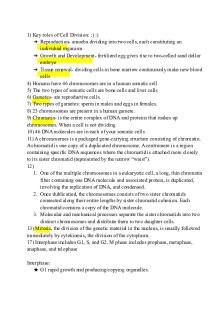Study Guide Chapter 12 PDF

| Title | Study Guide Chapter 12 |
|---|---|
| Author | Dakota Bartsch |
| Course | Natural Disasters |
| Institution | Utah State University |
| Pages | 2 |
| File Size | 70.2 KB |
| File Type | |
| Total Downloads | 4 |
| Total Views | 147 |
Summary
Study guide from chapter for weekly quizzes and unit exams...
Description
Dakota Bartsch A01823843 Unit 4: Assignment 2
Exam 4 Study Guide: Part 2 Chapter 12: Climate and Climate Change Instructions: Use the chapter 12 reading and lecture materials to answer the following questions. Some questions have multiple parts so carefully read the questions and provide detailed and specific responses. Generally, the difference between a good grade and a poor grade on an assignment is based on whether or not the questions were answered completely. The purpose of this assignment is to test your understanding of course materials covered from Chapter 12. Additionally, this assignment doubles as Part 2 of the Exam 4 study guide. 1. Explain the difference between climate and weather. (1 pt) Climate is the long term conditions of the atmosphere over a region, and weather is the atmospheric conditions over a region over a short period of time. 2. What are the major permanent and variable gases in the atmosphere? (1 pt) Permanent gases include nitrogen and oxygen. Variable gasses are composed of different proportions and include carbon dioxide. 3. Differentiate between instrumental records, historical records, and paleo-proxy records as they relate to climate data. (1 pt) The instrumental record is the oldest record and measures temperature and carbon dioxide levels. The historical record are written recollections that may contain weather data. The paleo-proxy record is short and the information is not numerical, it is collected as an earth science. 4. Define the greenhouse effect and which greenhouse gasses are involved. (1 pt) The greenhouse effect is evident when sunlight enters the earth’s atmosphere, is reflected, and stays within the atmosphere instead of leaving it. It contains carbon dioxide, methane, nitrogen oxides, and chlorofluorocarbons. 5. Define climate forcing. What are the main forcing variables that influence global warming? (1 pt) Climate forcing is an imposed change of Earth’s balance of energy. Solar forcing is when the heat of the sun warms the earth, volcanic forcing is when heated aerosols are hurled into the air, anthropogenic forcing is when the warming of the earth is related to human activity usually by emissions of greenhouse gasses. 6. Explain the ocean conveyor belt and why it is important. (1 pt) Warm surface water is transported westward and northward, it cools down while in the North, gains density, and sinks lower. The lower waters flow south and then east to the pacific. Without the warm waters flowing, heat would not be released into the atmosphere near northern Europe to keep it warm.
7. What are three lines of evidence that support the hypothesis that anthropogenic climate change? (1 pt) 1. Recent warming over the past few decades cannot be completely explained by natural causes. 2. Emissions of carbon dioxide have increased along with other greenhouse gasses. 3. The changes in Earth’s temperature are explainable when anthropogenic causes are combined with natural ones. 8. What are the potential effects of global climate change? (1 pt) Most importantly, our glaciers and sea ice will melt at a faster rate. Rainfall patterns will change, leading to different levels of moisture. Sea-levels will rise causing potential floods. Wildfires are predicted because of the increase in drought. Changes in the biosphere will threaten some ecosystems. 9. How is climate change effecting sea level change? What are the consequences of this change? (1 pt) Our sea-levels are effected by climate change because as water is warmed, it expands. Melting ice has a small contribution to the rising levels, and the rates of thermal expansion and ice melting are both increasing. 10. What is the primary management strategy for reducing the impacts of global warming? (1 pt) Reducing emissions of greenhouse gases, particularly carbon dioxide. Global warming is a natural process, and will still occur, but we can do our part to keep it from going out of control....
Similar Free PDFs

Chapter 12 Study Guide
- 4 Pages

Study Guide Chapter 12
- 3 Pages

Study Guide Chapter 12
- 2 Pages

AP -Chapter 12 study guide
- 39 Pages

Chapter 12 6e study guide
- 8 Pages

Chapter 12 Mitosis Study Guide
- 4 Pages

Chapter 12 study guide pharm
- 4 Pages

Oblicon Study Guide (12)
- 5 Pages

Quiz 12 Study Guide
- 2 Pages

Chapter 12 Review Guide
- 7 Pages

Ch. 12 GEO Study Guide
- 4 Pages

Case study chapter 12
- 19 Pages
Popular Institutions
- Tinajero National High School - Annex
- Politeknik Caltex Riau
- Yokohama City University
- SGT University
- University of Al-Qadisiyah
- Divine Word College of Vigan
- Techniek College Rotterdam
- Universidade de Santiago
- Universiti Teknologi MARA Cawangan Johor Kampus Pasir Gudang
- Poltekkes Kemenkes Yogyakarta
- Baguio City National High School
- Colegio san marcos
- preparatoria uno
- Centro de Bachillerato Tecnológico Industrial y de Servicios No. 107
- Dalian Maritime University
- Quang Trung Secondary School
- Colegio Tecnológico en Informática
- Corporación Regional de Educación Superior
- Grupo CEDVA
- Dar Al Uloom University
- Centro de Estudios Preuniversitarios de la Universidad Nacional de Ingeniería
- 上智大学
- Aakash International School, Nuna Majara
- San Felipe Neri Catholic School
- Kang Chiao International School - New Taipei City
- Misamis Occidental National High School
- Institución Educativa Escuela Normal Juan Ladrilleros
- Kolehiyo ng Pantukan
- Batanes State College
- Instituto Continental
- Sekolah Menengah Kejuruan Kesehatan Kaltara (Tarakan)
- Colegio de La Inmaculada Concepcion - Cebu



